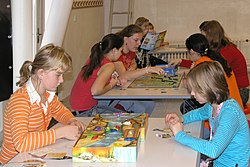Niagara (game)
| Niagara | |
|---|---|
 In the middle of the Niagara part |
|
| Game data | |
| author | Thomas Liesching |
| publishing company |
Zoch Verlag , Rio Grande Games , Gigamic , 999 Games , Marektoy , u. a. |
| Publishing year | 2004 |
| Art | Board game |
| Teammates | 3 to 5 |
| Duration | 30 to 45 minutes |
| Age | from 8 years
|
| Awards | |
|
Game of the Year 2005 |
|
Niagara is a board game by Thomas Liesching that was published in 2004 by Verlag Zoch . The game was voted Game of the Year 2005, came 2nd at the German Games Prize and came third in the “Family Game ” category at the Swiss Games Prize .
Theme of the game and equipment
Players move small wooden canoes on a raging river to extract gemstones of different colors from downstream bays and bring them to the safe beach. Dangers lurk along the way, such as falling over the waterfall or predatory players.
It's about planning cleverly and taking into account the moves of your fellow players.
The unusually shaped game board is placed over the box and represents the river with the bays. The river bed and the bays are a few millimeters lower than the rest of the board. At one end is the safe beach, at the other, flaps of the board hang over the edge of the box - the waterfall.
Flat, round disks made of clear plastic are placed in the river bed, on these the boats move in the moves and the disks themselves move with the flow of the river. The canoes are made of wood painted in the player's colors, the gems of plastic. The game features the following components:
- Game board
- 10 ships in 5 colors
- a starting player ring
- a cloud
- 12 river fields
- 40 gemstones in 5 colors
- 35 paddle cards in 5 colors
The expansion includes River Spirits at Niagara
- 7 boats
- 1 beaver
- 1 moose
- 25 paddle cards and a sticker
and can only be played with the original version.
The mini expansion Diamonds Joe contains a natural-colored canoe, a small set of rules and a cotton bag. This small extension was temporarily available from the game publisher, but is now out of stock.
Game flow
Each player has a limited number of movement points that are played in rounds. A point can be used to move up or down the river or to enter and exit the five gemstone bays. One player has two canoes; the movement applies to all canoes that are currently in the water. Only when moving against the current can a player with an empty canoe rob their fellow players and acquire their gem.
Once every seven rounds, everyone plays a special card with which they can change the flow of the river to accelerate or slow down. After the movement round, the flow of the river takes effect. The current can bring a canoe from near the entrance on the beach to the precious gemstone bays or it can tip mercilessly over the edge of the waterfall. Crashed canoes are lost, but can be used again by paying with a gem. Fortunately, the river speed drops in half at the fork.
If a player has transported the minimum number of gems to the safe beach, the current round is completed and the game ends with it. This means that there can be several winners.
Game strategy
Since the points of movement are limited, it is advisable to leave the forward movement at least partially to the current and to use the points on the way back to the rescue beach if possible. In order to get hold of gemstones of a missing color, it can also make sense to place a gemstone in a bay on the way back and instead steal a different color from another player.
Target group and assessment
Like almost all games of the year, Niagara is a family game . The gameplay is easy to grasp, and you don't need much experience to develop a strategy.
Web links
- Niagara at Zoch Verlag
- Niagara in the Luding games database
- Niagara in the game database BoardGameGeek (English)
- Rules of the game for Niagara (PDF document; 1.6 MB)
- Rules of the game for Niagara: Diamonds Joe (PDF document; 120 kB)
Individual evidence
- ^ Niagara: Diamonds Joe at spiele-check.de